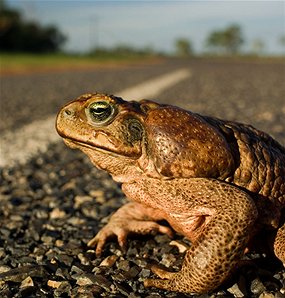Toads ramp up fitness regime for invasion
 A newly-published study has revealed there are some front-runners among cane toad populations, with evidence leading to the identification of an evolutionary phenomenon dubbed the ‘Olympic village effect’.
A newly-published study has revealed there are some front-runners among cane toad populations, with evidence leading to the identification of an evolutionary phenomenon dubbed the ‘Olympic village effect’.
An Australian study now published in the US Proceedings of the National Academy of Sciences has revealed some toads will dash into areas untainted by the reptilian pest at an incredible rate, hopping along a straighter path and at a higher speeds than their encamped brethren. These ‘pioneer toads’ are apparently giving 100 per cent to their chosen pursuit, with many found to have injured their spines or fallen victim to arthritis as a result of their athletic tendencies.
Researchers found that the high-speed toads were a magnet for females; in what may be dubbed the ‘Usain Bolt effect’ - the sportier toads were seen as hot property and frequently got to pass on their pioneering genes. The result has lead to a minor evolution in the population, amplifying their invasive nature.
The rapid spread of cane toads has been a cause for concern since soon after they were introduced in the failed effort to eliminate cane beetle populations. Toads have recently been reported crossing through Western Australia and south from Queensland through New South Wales.
The new study was based on data from cane toads tracked since their arrival in the Adelaide River floodplain, south-east of Darwin, eight years ago; it involved researchers from NSW and James Cook universities.
The report has been reviewed and published in the Proceedings of the National Academy of Sciences.








 Print
Print